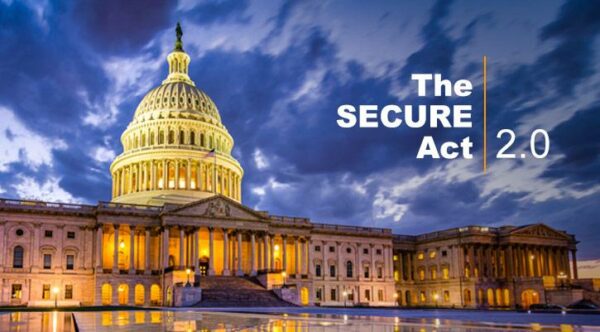On December 23, 2022, President Biden signed a $1.7 trillion budget bill. The bill includes a number of provisions that directly effect the retirement planning industry. Per usual, the bill is a massive document so it will take some time to digest all the changes. However, we figured you’d appreciate some high-level information about how the bill will be changing the retirement landscape.
Key provisions of SECURE 2.0:
Required Minimum Distributions (RMDs)
Under current law, most people are required to begin withdrawing funds from their pre-tax retirement accounts every year after they turn 72. With SECURE 2.0, that age increases to 73 beginning in 2023, and jumps to 75 in 2033.
Catch-up Provisions
Currently, individuals can contribute an extra $7,500 to their 401(k) or 403(b) once they turn 50. Under the new legislation, beginning in 2025, an additional catch-up is created for people between 60 and 63. During those years, individuals can contribute an extra $10,000 to their qualified retirement plans. For Simple IRAs, the catch-up increases to $5,000 from $3,500 in 2025. These catch-up contributions will adjust each year due to inflation.
Additionally, beginning in 2024, catch-up contributions will be made on an after-tax basis, meaning they’ll be taxed like Roth IRAs or Roth 401(k)s.
Mandatory Enrollment
Beginning 2025, new 401(k) and 403(b) plans will be required to automatically enroll newly eligible employees. Automatic deferrals can start between 3% and 10% of compensation, and they increase by 1% each year up to a maximum of 10%-15%. Employees may opt out of the plans if they like.
Company Match for Students
Often people at the beginning of their careers need to choose between paying down their student loans or saving for retirement. SECURE 2.0 allows companies to make matching contributions to an employee’s retirement account for qualifying student loan payments. This will allow younger employees to get their retirement accounts started while still paying down loans.
Emergency Withdrawals
SECURE 2.0 allows for penalty-free withdrawals of up to $1,000 in the event of “unforeseeable or immediate financial needs relating to necessary personal or family emergency expenses.” You’ll still owe ordinary income tax on the withdrawals, but the 10% penalty will be waived. These distributions can only be made every three years, or every year if the distribution is repaid within three years.
Nationwide Database to locate old plans
The Act creates a national database that will allow individuals to see if they have any orphan retirement plans hanging around from old employers. It also creates some additional options for rolling those plans into your new employer’s plan.
There a many other provisions and details included in the SECURE 2.0 Act, and we’ll be staying up to date on the latest developments. As always, we’ll keep you updated on issues that affect your personal situation. We’re here for any questions or concerns you may have.
These are the opinions of Legacy Wealth Management, LLC and not necessarily those of Cambridge, are for informational purposes only, and should not be construed or acted upon as individualized investment advice. Dan Funderburk is a Registered Representative offering securities through Cambridge Investment Research, Inc., a Broker/Dealer, Member FINRA/SIPC. Investment Advisor Representative, Cambridge Investment Research Advisors, Inc., a Registered Investment Advisor. Legacy Wealth Management, LLC and Cambridge are not affiliated. Cambridge does not offer tax advice. Copyright ©2023 Dan Funderburk. All Rights reserved. Commercial copying, duplication or reproduction is prohibited.

